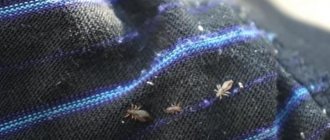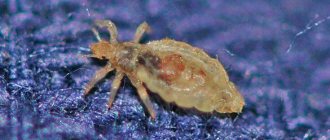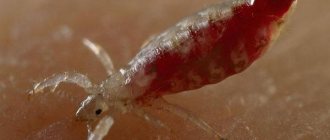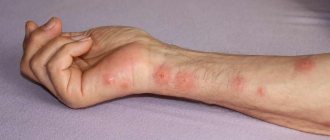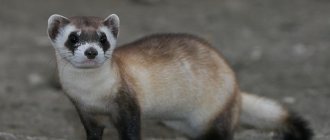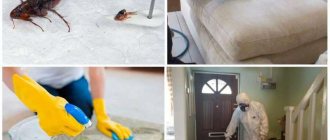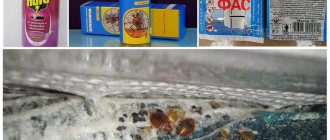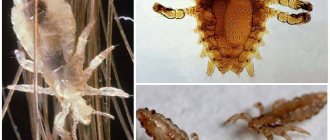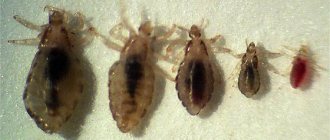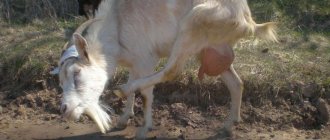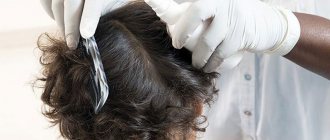The linen louse is not an independent species, it is just a type of head louse. But they prefer fleecy clothes to their heads, where they live most of their cycle. Nature has adapted linen lice (by the way, that’s what people call them, the correct name is body louse) to live in clothes. They have devices on their paws that allow them to easily cling to fabrics.
Although this subspecies will never live on the head, it is capable of interbreeding with head lice. The place of residence of these insects is human underwear, hence their name. Their source of nutrition is human blood, and they have very good access to it while wearing underwear. It must be said that the body louse is a rather fastidious parasite, and it will only live in conditions that completely suit it. The well-being of body lice depends on the behavior of the person infected with this scourge. It is possible to get rid of this type of parasite, and this can be done quite quickly with or without the use of chemicals. But the methods of killing linen lice are somewhat different from the methods by which they get rid of other types of these parasites.
Linen lice: photo, characteristics, living conditions
An interesting fact is that linen lice are gradually evolving into an independent species, currently being a subspecies of head lice and having the ability to mate with them. They only live on certain types of fabrics, for example, they will never live in clothes made of wool, and all due to the fact that people do not wear woolen clothes directly on their bodies. Also, these insects really do not like silk and other smooth clothes, but they will feel comfortable on cotton and linen.
These insects live only on humans; animal blood is not suitable for them. They are not able to go without food for a long time; a day of hunger can become a critical time for them. In order to always have the opportunity to eat, insects are constantly near the human body in order to immediately have a snack as soon as the need arises, and it occurs about 5 times a day. By the way, one of the main methods of removing head lice is based on their fasting. If the clothes that these insects have chosen as their home are not worn within 5 days, the parasites die.
People whose wardrobe is quite diverse have reliable protection against infection by these insects, because even if a louse accidentally gets on an item of clothing, it may well die while the person is not using it. From this we can conclude that linen lice are permanent residents on the clothes of homeless people and other asocial elements. A declassed lifestyle is a guarantee of infection with linen lice.
Mechanical method
You may be interested in: Worms: symptoms, treatment with medications and folk remedies
How to remove lice from long hair? For this, a mechanical method can be used, which is also considered cheap. You don't need to use any medications with it. All you need is patience and:
- thick comb;
- lamp;
- magnifying glass
If you are interested in how to remove lice and nits from a child, then you should use this method. Parents should be prepared to calm their child. For example, turning on your favorite cartoon will help. The shorter the hair and the earlier the problem is identified, the easier it will be to fix it. The procedure is performed according to the following instructions:
A towel is placed over the child's shoulders to prevent lice from getting on clothes. The combing procedure should be done in the bathroom to make it easier to wash the parasites down the drain. In just 1 day at home, you can completely eliminate lice and nits if you do everything according to the instructions, sort through the hairs and comb out the nits.
A magnifying glass is useful to speed up the process, since nits are clearly visible with a magnifying glass. After a couple of weeks, the head should be examined again. In this case, you should not allow at least one nit to be on the hair.
Appearance of linen lice
In appearance they resemble head ones; they can reach 2-3 mm in length. If you look closely, the edges of the abdomen consist of folds that straighten when the insect takes the next portion of food. Still, there are signs by which a linen louse differs from a head louse: we are talking about color - body lice are almost white. But only a hungry louse has this color; when it is filled with blood, its color turns brown.
The appearance of linen lice larvae is no different from the appearance of adult individuals; they differ only in size. The nits of both types of lice also look the same, but the process of their development occurs in completely different places: if the nits of head lice are attached to the hair at a short distance from the head, then female linen nits lay their eggs in the folds of clothing. They look for the most secluded places where they will be more difficult to detect - pockets, folds. It is very difficult to detect linen louse nits without using magnifying glasses due to their very small size - 0.5 mm.
Linen lice are distinguished by their front legs - they are widely spaced and have a powerful appearance. They also differ from head lice in their manner of behavior: on clothing they prefer to stay in groups, and only when feeding on a human body can they be alone. And these parasites spend most of their time on laundry. Lice crawl onto the human body only when they want to eat. But since they live on their underwear, this journey cannot be called long.
In the oral cavity of insects there are peculiar protrusions with which they make injections and suck blood. At the same time, to prevent blood clotting, when they bite, they inject a special substance, which is the cause of allergies to bites in some people. At the sites of bites on the human body, spots with a bluish tint form.
Linen lice are hardy insects, since the temperature range in which they can feel comfortable is wide - from 0 to 45 degrees Celsius. Young insects, the so-called nymphs, are not so hardy; they can exist at temperatures of 0-40 degrees Celsius. But both nymphs and adult insects feel most comfortable at 31-32 degrees Celsius. The activity of parasites slows down noticeably if the items of clothing on which they live are not worn for some time. It should be borne in mind that linen lice love humidity, and they will breed most actively where the humidity is high.
The life cycle of body lice reaches 45 days. They can live longer if the air temperature is slightly lower than what is optimal for them. Then their life processes begin to occur more slowly, and the size of the insects also becomes smaller.
Food intake for linen lice is not regulated, but they feed up to 5 times a day, consuming up to 0.5 ml of blood each time.
Lice will not necessarily be on the underwear of an infected person; with advanced lice, they crawl in different directions.
Body lice appear where there is unsanitary conditions, since then excellent conditions are created for their reproduction. Homeless people and other people leading a corresponding lifestyle meet these conditions.
Regular washing will not help destroy lice, because they can remain in water for 2 days. Systematic change of underwear will also not help to destroy these insects, because if a piece of clothing is worn at least once every few days, there may well remain insects whose life processes have slowed down, but they are still alive, only slightly reduced in size. They will very quickly return to their previous form if they feed on blood for at least 1 day.
Here are the signs by which linen lice are distinguished from other parasites:
- They are distinguished from fleas by their color. Fleas are much darker.
- Bedbugs are also much darker than lice, and they are much larger in size. And bugs feed only at night, while lice bite at any time of the day.
- Lice also differ from ticks in their lighter color and the number of limbs - lice have 6, and ticks have 8.
- As already mentioned, linen lice are very similar to head lice, and they are also very different from pubic lice. The pubic louse resembles a crab due to its wide abdomen.
Nymphs of body lice are not much different from adult individuals; the differences concern only the reproductive system, which in nymphs is in an underdeveloped state. Nymphs also feed only on human blood; they behave in the same way as adults. During her life cycle, the female is capable of laying up to 150 eggs. Every day she lays 3-4 nits. If external conditions meet the standards (30-35 degrees Celsius), then the incubation period will last no more than 5 days. Nits are very tenacious, and it is not so easy to destroy them. If the clothes on which they are deposited are not worn for some time, then the process of their development is preserved; the preservation period can last up to 2 months.
When the larva emerges from the egg, it immediately begins to feed, after which its first molt occurs. There will be 3 molts in total over 9 days. Then the nymph will completely transform into an adult. If measures are not taken in time, then within 20 days the number of lice can increase many times over, so after the first signs of head lice appear, it is necessary to immediately take the necessary measures.
Briefly about these insects
There are three types of lice:
- Clothes.
- Pubic.
- Head ones.
- The hair was in contact with lousy strands.
- Someone else's comb or headdress was used.
- The child touched soft toys in public places.
- Sleeping on an infected pillow.
The latter type can get on the hair in various ways:
You may be interested in: Eye diseases in humans: list of diseases, symptoms and treatment features
At a speed of 35 cm/min, the parasite can crawl from one object to another. Therefore, lice spreads instantly in schools and kindergartens.
Insect bites cause itching. Scratching causes micro-wounds to form on the skin: from boils to typhus. The patient sleeps less, scratches the bitten areas, wanting to crush the bloodsucker and eliminate the itching. But this is impossible, since lice, like other parasites, multiply quickly.
Pest eggs, called nits, are able to cling to the hair roots with an adhesive substance. After 10 days they become larvae, turning into individuals up to 5 mm long.
How to remove lice at home? In this case, simple hygiene procedures will not help. It is necessary to use proven means, which will be discussed below.
What are bites? What they look like
The symptoms of linen lice lesions differ only slightly from the bites of other blood-sucking lice, but some features are still present. Basically, the specificity of their bites is expressed in the sensations of the one they bite. A linen louse can bite any part of the body that comes into contact with clothing - it could be arms, legs, back, etc. Other varieties of these parasites are not capable of this.
Symptoms and appearance of the bite
A person begins to suspect the presence of insects after lesions resembling insect bites appear on the body. It is very important to immediately determine which insect caused these lesions. After this, a decision should be made regarding measures to remove parasites. It is necessary to be able to distinguish the symptoms of lesions caused by lice in order to accurately determine the fact of their presence.
The bites of linen parasites are not much different from the bites of other insects - they are a red swelling that constantly itches and is located at some distance from other affected areas of the skin. Each swelling is crowned with a black dot - this is, in fact, a wound left by an insect when it punctures the skin. Through this hole the louse sucked blood.
A person will not immediately feel the bite, as the insect introduces a special enzyme for pain relief. At first, the bite is felt as a slight tingling sensation; it begins to itch only after a while, when the louse has already crawled to a safe distance.
The localization of bite sites is in the folds of clothing - armpits, lower back, etc. But this does not mean that these parasites do not bite other parts of the body; bite sites can be found anywhere. It must be said that the bites are very painful and very itchy. At the same time, the desire to scratch seems natural, but you need to control yourself in order to avoid the appearance of characteristic scratches on the body.
And now about the symptoms of linen lice in more detail:
- There is a red rash all over the body. This also applies to those areas where no bites were found. The whole body itches and hurts after scratching.
- Since the desire to scratch with head lice is inevitable, scars will eventually appear on the body; they can be deep.
- Pigment spots may form at the affected sites, indicating the presence of an allergic reaction in the infected person.
- In advanced cases, ulcers may well form on the body, which will certainly develop into pyoderma if a course of treatment is not carried out.
- Very advanced cases (happens to homeless people and other non-social elements) are characterized by thickening of the skin and its excessive pigmentation.
Usually people get rid of parasites at their first signs, but when proper measures are not taken for years, pediculosis goes into a neglected state, and this already threatens with serious consequences.
Characteristic signs of body lice bites
Of course, body lice bites are very similar to the bites of any other blood-sucking insect, but they still have their own characteristic signs:
- If there is a whole path on the body consisting of bite sites, then this is a clear sign of the presence of bedbugs. These insects try to make as many punctures as possible. There is no sequence in the bites of linen lice; they bite only in one place.
- Lice bites differ from flea bites in that they are much less painful. The fact is that nature did not take care of the secrecy of fleas, because they are very difficult to catch, but lice inject an anesthetic substance, since they are clumsy, and it is much more difficult for them to hide from persecution. In addition, flea bites, like bedbugs, are also located in the form of paths.
- Wounds caused by lice differ from tick bites by being slightly painful. After a tick, significant swelling remains on the body. In addition, the tick, having attached itself to the human body, remains in one place for a very long time, while the time the lice eat does not exceed several minutes.
- Lice bites can be confused with wounds left by mosquitoes, but mosquito bites do not have a black dot in the middle. And mosquitoes don’t bite under clothes, which, of course, cannot be said about linen lice.
- If the body is very itchy, but there are no signs of punctures, then the cause is not lice, but most likely scabies mites.
What dangers do parasite bites pose?
We have already talked about the possibility of pyoderma, but this is not the only danger that lice bites can cause. Lice may well be carriers of fever and even typhoid. In ancient times, these diseases were a real disaster for all peoples, but today they remain only in undeveloped countries.
In addition, lice may well be carriers of rickettsia - these are very dangerous bacteria that can cause several diseases similar to each other. And in the tropics, lice carry many more diseases that are unknown in temperate countries. Therefore, there are a lot of diseases that can be caused by lice. Be sure to consult a doctor if you experience nausea, fever, or increased temperature while having lice; these may well be symptoms of diseases caused by lice bites.
Where can you “catch” the infection?
- Linen lice can change hosts during close contact between people.
- There is a high probability of infection in crowded places.
- If people share the same items of clothing, this can also cause infection.
- In places where used clothing is sold, the presence of parasites is also possible.
- Lice can stay in water for up to 2 days, so they can be “picked up” in public bathing areas, for example, in swimming pools.
"Dichlorvos"
How to remove lice at home? Dichlorvos is used, which is considered a radical method of eliminating parasites. This is a broad-spectrum insecticide, so it perfectly gets rid of many insects, leading to paralysis of adults.
But the product has many side effects, so it is rarely used to kill parasites in the home. It is important to analyze the consequences of using Dichlorvos. Poisoning can occur after inhalation of insecticide vapors or when the composition penetrates the skin. Intoxication causes:
- dizziness;
- nausea and vomiting;
- seizures;
- hives;
- motor impairment;
- loss of consciousness.
Therefore, Dichlorvos is used quite rarely. It is better not to use it for children.
How to get rid of laundry parasites
Almost all options for combating lice are based on their poisoning. Before treating clothes, you need to wash yourself using special shampoos - Medifox, Veda-2 or Lauri. This measure will ensure that no lice remain on the body.
Then you need to process the laundry using the following methods:
- Infected items are boiled for 20 minutes. Boiling should be done in water with the addition of special insecticidal preparations containing Permethrin - this is the most effective substance that can destroy linen parasites.
- If you have any suspicions about one of the items of clothing, you should hang it on the balcony. It is desirable that the weather be sunny, but since this is not always possible, you can hang out the laundry in any weather, the main thing is not to take it off for a week, during which time the insects in the clothes will die. Lice cannot go long without food, and hunger will certainly destroy them.
- If the infection is not in the first stage, the clothes should be treated in a special formaldehyde chamber. Of course, it is difficult for the average person to find an opportunity to do this, then dry cleaning can help.
The fight against body lice is not as troublesome as the destruction of head lice, but it can also be associated with a number of difficulties. In former times, body lice were most often gotten rid of using kerosene. This, of course, is an effective remedy, and after soaking the contaminated laundry in kerosene, the lice will definitely disappear, but the smell will remain, which will be more difficult to get rid of than lice.
Today, special preparations are used to combat lice, which we will discuss below, but now the basic principles for treating contaminated clothing:
- Infected clothing is soaked using regular powder and a special insecticide for 45 minutes.
- During this time, the owner of contaminated clothing should wash himself using insecticidal preparations.
- After this, you need to put on clothes that have not been used for a long time, since the possibility of the presence of linen parasites on them is almost zero.
- Now the contaminated items should be washed in a washing machine, also using special products. It's better if the water is hot.
- Washed clothes should be boiled or, if it is frosty outside, frozen.
- Underwear treated in this way should be worn after a week.
- Be sure to treat your bedding in the same way, as parasites could easily live in them.
Acid and phytoncides
How to remove lice using folk remedies? Acids and phytoncides are also used for this. These products provide quick and effective results:
Effective means to combat linen lice
And now directly about the products that should be used when processing laundry:
A-par
This is perhaps the most effective drug. Its developers claim that it can get rid of not only lice, but also nits. Sold in aerosol form. It consists of two active components - Piperonibutoxide and Esdepalletrin. Before using the drug, things should be washed in the manner indicated above, after which the drug is sprayed over the entire surface of the clothing.
Akromed
The main active substance of this drug is Permethrin. It also contains kerosene, but there is no need to worry about the appearance of a characteristic odor. The drug is sold in the form of an emulsion, four liters of which is enough to treat 1 kilogram of things.
Forsyth
It is also a very effective drug, the main active ingredients of which are Permethrin and Fenthion. Sold in the form of an emulsion that requires preliminary preparation. 20 ml of the drug is diluted in a liter of water. To process a kilogram of things you will need 4 liters of ready-made solution. The treatment procedure requires repeating after a week.
Avicin
Active substance – Permethrin. To prepare the solution, take 1 part emulsion and 100 parts water. Soaking time for contaminated items is 25 minutes.
Celandine
The active substance of this drug is the same Permethrin. The drug is sold in the form of an emulsion, ready for use.
Oils
How to remove lice at home in a safe way? Oils are used for this. They block the path to oxygen, so the insects die. Recommended use:
- olive;
- mustard;
- corn;
- sunflower.
The method of application is quite simple: lubricate your hair with it, wrap it in cling film for 2 hours. You can wrap a towel on top. The oil not only fights parasites, but also makes it easier to comb out after the procedure is completed.
Let's look at how to remove lice with tea tree oil. It is necessary to prepare a medicinal solution. To do this, mix medical alcohol (30 ml), oil (25 drops), water (20 ml). The product is applied to the head. Cover the hair with cling film and wash it after 2 hours with shampoo. Lice are combed out with a fine comb. The procedure should be repeated until the insects are completely eliminated, given that the oil does not destroy them, but only temporarily paralyzes them.
Blood suckers are afraid of the aroma of geranium oil. You will need a few drops of ether, which are mixed with burdock oil. This mixture is also applied to the hair, then wrapped in polyethylene for a couple of hours. Then the shampoo should be rinsed off and the nits can be combed out.
In addition to geranium and tea tree, the following oils are suitable:
- peppermint;
- lavender;
- plantain;
- cypress;
- rosemary;
- lemon;
- calendula;
- sage;
- carnations;
- Agave.
The listed esters have a detrimental effect on parasites, effectively destroying them. Usually after the first procedure the effect is visible.
Folk remedies
There are also some folk methods for removing lice that are worth mentioning here:
Dust soap
A wonderful pediculicide, actively used by people. First, the soap is grated. The resulting shavings are dissolved in water and beaten. To completely remove lice, one treatment is sufficient. Remember that you need to carry out the processing procedure while wearing rubber gloves. Contact of dust soap with the skin is extremely undesirable. After the procedure, the laundry should be rinsed thoroughly. Do not neglect safety tips, as dust soap is a toxic substance.
Tar soap
This drug should be used like dust soap. Unlike the latter, tar soap does not pose a danger to human health. But the effectiveness of this remedy is much less.
Some herbs are also used against body lice, but it must be said that they are even less effective than tar soap, and they are used more as a prophylactic agent or for low degrees of infection.
You can wash infected laundry in mint decoction; the smell is simply disgusting to lice, but this remedy, of course, cannot be called effective. Lemon juice is also used to remove parasites; it is added in large quantities to the water in which contaminated laundry is washed. Also for this purpose, use an alcoholic infusion of angelica or a mint decoction.
Using infusion and decoction
What else can you use to get rid of lice? Elecampane root is considered effective. Both fresh and dried raw materials are suitable. The proportions are calculated independently: the more saturated the solution, the better. The grass and roots are immersed in boiling water for at least an hour. The composition is filtered, cooled and lubricated with hair. It is necessary to withstand for at least 8 hours, wrapping your head with cling film and a warming cap (towel). After washing your hair, you can comb your hair.
We also effectively remove lice and nits at home using a decoction of burdock. The roots and fruits of the plant must be poured with boiling water. After an hour, strain and wash your hair with the broth. Then comb out with a fine-toothed comb. Sessions are performed every day until the bloodsuckers are completely eliminated.
Prevention of linen lice
Of course, it is impossible to insure yourself against infestation with linen lice, but it is still worth taking a set of measures that will help prevent the appearance of parasites.
- First, don't wear items that other people use, especially items that come into contact with your body. If you happen to spend some time in places where it is quite possible to find people infected with lice, be sure to carry out personal disinfection upon arrival home.
- Try not to communicate with antisocial elements. Experts highly recommend dry cleaning bedding at least once every 6 months. Upholstered furniture should also be treated with special products. And of course, maintain cleanliness, as this is the main condition for ensuring that you and your loved ones will not be infected with linen lice.
Getting rid of body lice is easier than getting rid of head lice, but you need to start doing this as soon as the first signs of infection appear, because the sooner you begin to destroy the parasites, the greater the likelihood that they will disappear quickly and completely.
Apartment disinfection
To get rid of linen lice in an apartment, you need to completely disinfect it. To treat all existing surfaces, including floors, walls and cabinet furniture, a 2% DDT emulsion is used, after which after a couple of hours all surfaces should be washed with soap and water, since DDT, even in low dosages, has toxic properties.
Dust (DDT)
It is advisable to treat sleeping places, mattresses, and upholstered furniture properly, without missing a single area, with a household steam generator, but for carpets, blankets, rugs this will not be enough - they will have to be dry-cleaned.
Precautionary measures
All of the above methods are not considered completely reliable. Each of us has an individual body: what is effective for one may lead to negative reactions in another. Therefore, before using any product, it is necessary to conduct a test on the bend of the elbow to exclude an allergic reaction.
If lice lead to severe itching and irritation and damage appear on the scalp, then the method with acids should be postponed until the skin heals. In this case, it is advisable to start treatment with essential oils. Before using folk and medical remedies, it is advisable to consult a doctor.
Head lice can affect anyone, since there are no vaccinations against this problem. The disease often occurs in children. There is an opinion that lice appear in children with reduced immunity. Almost every person has had this disease at least once in their life. What is better to use – medical remedies or traditional methods is a personal choice for everyone.
